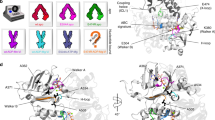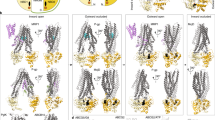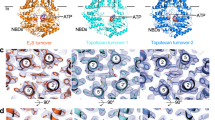Abstract
The conformational dynamics in ABC transporters is largely elusive. The ABC importer GlnPQ from Lactococcus lactis has different covalently linked substrate-binding domains (SBDs), thus making it an excellent model system to elucidate the dynamics and role of the SBDs in transport. We demonstrate by single-molecule spectroscopy that the two SBDs intrinsically transit from open to closed ligand-free conformation, and the proteins capture their amino acid ligands via an induced-fit mechanism. High-affinity ligands elicit transitions without changing the closed-state lifetime, whereas low-affinity ligands dramatically shorten it. We show that SBDs in the closed state compete for docking onto the translocator, but remarkably the effect is strongest without ligand. We find that the rate-determining steps depend on the SBD and the amino acid transported. We conclude that the lifetime of the closed conformation controls both SBD docking to the translocator and substrate release.
This is a preview of subscription content, access via your institution
Access options
Subscribe to this journal
Receive 12 print issues and online access
$189.00 per year
only $15.75 per issue
Buy this article
- Purchase on Springer Link
- Instant access to full article PDF
Prices may be subject to local taxes which are calculated during checkout






Similar content being viewed by others
References
Higgins, C.F. ABC transporters: from microorganisms to man. Annu. Rev. Cell Biol. 8, 67–113 (1992).
Biemans-Oldehinkel, E., Doeven, M.K. & Poolman, B. ABC transporter architecture and regulatory roles of accessory domains. FEBS Lett. 580, 1023–1035 (2006).
Biemans-Oldehinkel, E., Mahmood, N.A. & Poolman, B. A sensor for intracellular ionic strength. Proc. Natl. Acad. Sci. USA 103, 10624–10629 (2006).
Rees, D.C., Johnson, E. & Lewinson, O. ABC transporters: the power to change. Nat. Rev. Mol. Cell Biol. 10, 218–227 (2009).
Doeven, M.K., Abele, R., Tampe, R. & Poolman, B. The binding specificity of OppA determines the selectivity of the oligopeptide ATP-binding cassette transporter. J. Biol. Chem. 279, 32301–32307 (2004).
van der Heide, T. & Poolman, B. Osmoregulated ABC-transport system of Lactococcus lactis senses water stress via changes in the physical state of the membrane. Proc. Natl. Acad. Sci. USA 97, 7102–7106 (2000).
Sharom, F.J. ABC multidrug transporters: structure, function and role in chemoresistance. Pharmacogenomics 9, 105–127 (2008).
Nagao, K., Kimura, Y., Mastuo, M. & Ueda, K. Lipid outward translocation by ABC proteins. FEBS Lett. 584, 2717–2723 (2010).
Holland, I.B., Cole, S.P., Kuchler, K. & Higgins, C.F. ABC Proteins: from Bacteria to Man (Academic Press, 2003).
van der Heide, T. & Poolman, B. ABC transporters: one, two or four extracytoplasmic substrate-binding sites? EMBO Rep. 3, 938–943 (2002).
Fulyani, F. et al. Functional diversity of tandem substrate-binding domains in ABC transporters from pathogenic bacteria. Structure 21, 1879–1888 (2013).
Davidson, A.L., Dassa, E., Orelle, C. & Chen, J. Structure, function, and evolution of bacterial ATP-binding cassette systems. Microbiol. Mol. Biol. Rev. 72, 317–364 (2008).
Oldham, M.L., Davidson, A.L. & Chen, J. Structural insights into ABC transporter mechanism. Curr. Opin. Struct. Biol. 18, 726–733 (2008).
Locher, K.P. Structure and mechanism of ATP-binding cassette transporters. Phil. Trans. R. Soc. Lond. B 364, 239–245 (2009).
Oldham, M.L., Khare, D., Quiocho, F.A., Davidson, A.L. & Chen, J. Crystal structure of a catalytic intermediate of the maltose transporter. Nature 450, 515–521 (2007).
Khare, D., Oldham, M.L., Orelle, C., Davidson, A.L. & Chen, J. Alternating access in maltose transporter mediated by rigid-body rotations. Mol. Cell 33, 528–536 (2009).
Bao, H. & Duong, F. ATP alone triggers the outward facing conformation of the maltose ATP-binding cassette transporter. J. Biol. Chem. 288, 3439–3448 (2013).
Schuurman-Wolters, G.K. & Poolman, B. Substrate specificity and ionic regulation of GlnPQ from Lactococcus lactis: an ATP-binding cassette transporter with four extracytoplasmic substrate-binding domains. J. Biol. Chem. 280, 23785–23790 (2005).
Berntsson, R.P.A., Smits, S.H.J., Schmitt, L., Slotboom, D.-J. & Poolman, B. A structural classification of substrate-binding proteins. FEBS Lett. 584, 2606–2617 (2010).
Clore, G.M. Interplay between conformational selection and induced fit in multidomain protein-ligand binding probed by paramagnetic relaxation enhancement. Biophys. Chem. 186, 3–12 (2014).
Tang, C., Schwieters, C.D. & Clore, G.M. Open-to-closed transition in apo maltose-binding protein observed by paramagnetic NMR. Nature 449, 1078–1082 (2007).
Csermely, P., Palotai, R. & Nussinov, R. Induced fit, conformational selection and independent dynamic segments: an extended view of binding events. Trends Biochem. Sci. 35, 539–546 (2010).
Kim, E. et al. A single-molecule dissection of ligand binding to a protein with intrinsic dynamics. Nat. Chem. Biol. 9, 313–318 (2013).
Oldham, M.L. & Chen, J. Crystal structure of the maltose transporter in a pretranslocation intermediate state. Science 332, 1202–1205 (2011).
Oldham, M.L., Khare, D., Quiocho, F.A., Davidson, A.L. & Chen, J. Crystal structure of a catalytic intermediate of the maltose transporter. Nature 450, 515–521 (2007).
Oldham, M.L. & Chen, J. Crystal structure of the maltose transporter in a pretranslocation intermediate state. Science 332, 1202–1205 (2011).
Mao, B., Pear, M.R., Mccammon, J.A. & Quiocho, F.A. Hinge-bending in L-arabinose-binding protein: the venus-flytrap model. J. Biol. Chem. 257, 1131–1133 (1982).
Bermejo, G.A., Strub, M.P., Ho, C. & Tjandra, N. Ligand-free open-closed transitions of periplasmic binding proteins: the case of glutamine-binding protein. Biochemistry 49, 1893–1902 (2010).
Ha, T. et al. Probing the interaction between two single molecules: fluorescence resonance energy transfer between a single donor and a single acceptor. Proc. Natl. Acad. Sci. USA 93, 6264–6268 (1996).
Kapanidis, A.N. et al. Fluorescence-aided molecule sorting: analysis of structure and interactions by alternating-laser excitation of single molecules. Proc. Natl. Acad. Sci. USA 101, 8936–8941 (2004).
Lee, N.K. et al. Accurate FRET measurements within single diffusing biomolecules using alternating-laser excitation. Biophys. J. 88, 2939–2953 (2005).
van der Velde, J.H.M. et al. Mechanism of intramolecular photostabilization in self-healing cyanine fluorophores. ChemPhysChem 14, 4084–4093 (2013).
Seo, M.-H., Park, J., Kim, E., Hohng, S. & Kim, H.-S. Protein conformational dynamics dictate the binding affinity for a ligand. Nat. Commun. 5, 3724 (2014).
Chen, J. Molecular mechanism of the Escherichia coli maltose transporter. Curr. Opin. Struct. Biol. 23, 492–498 (2013).
Arnold, K., Bordoli, L., Kopp, J. & Schwede, T. The SWISS-MODEL workspace: a web-based environment for protein structure homology modelling. Bioinformatics 22, 195–201 (2006).
Biasini, M. et al. SWISS-MODEL: modelling protein tertiary and quaternary structure using evolutionary information. Nucleic Acids Res. 42, W252–W258 (2014).
Guex, N., Peitsch, M.C. & Schwede, T. Automated comparative protein structure modeling with SWISS-MODEL and Swiss-PdbViewer: a historical perspective. Electrophoresis 30 (suppl. 1), S162–S173 (2009).
Kiefer, F., Arnold, K., Kunzli, M., Bordoli, L. & Schwede, T. The SWISS-MODEL Repository and associated resources. Nucleic Acids Res. 37, D387–D392 (2009).
Blobel, G. & Dobberstein, B. Transfer of proteins across membranes. I. Presence of proteolytically processed and unprocessed nascent immunoglobulin light chains on membrane-bound ribosomes of murine myeloma. J. Cell Biol. 67, 835–851 (1975).
Leenhouts, K. et al. A general system for generating unlabelled gene replacements in bacterial chromosomes. Mol. Gen. Genet. 253, 217–224 (1996).
Geertsma, E.R. & Poolman, B. High-throughput cloning and expression in recalcitrant bacteria. Nat. Methods 4, 705–707 (2007).
Lanfermeijer, F.C., Picon, A., Konings, W.N. & Poolman, B. Kinetics and consequences of binding of nona- and dodecapeptides to the oligopeptide binding protein (OppA) of Lactococcus lactis. Biochemistry 38, 14440–14450 (1999).
Acknowledgements
We thank S. Weiss (University of California Los Angeles) and A.N. Kapanidis (University of Oxford) for providing software for data acquisition and analysis of ALEX data. This work was supported by grants from the Netherlands Organization for Scientific research (NWO; Top-subsidy grant 700.56.302 to B.P.), the Marie-Curie Initial Training Networks program Network for Integrated Cellular Homeostasis (NICHE) (coordinated by B.P.) and the Zernike Institute for Advanced Materials and the Centre for Synthetic Biology (University of Groningen startup grant to T.C.). G.G. is supported by a NWO-VENI grant (grant no. 722.012.012). E.P. acknowledges a postdoctoral fellowship from the German Science Foundation (DFG; grant PL696/2-1). We thank R.M. Scheek for assistance with the data analysis.
Author information
Authors and Affiliations
Contributions
G.G., G.K.S.-W., E.P., M.d.B., T.C. and B.P. designed experiments and analyzed and interpreted the data. G.G., G.K.S.-W., E.P., F.H., R.V. and T.C. performed experiments. G.G., G.K.S.-W., E.P., T.C. and B.P. wrote the manuscript. All authors approved the final version of the manuscript.
Corresponding authors
Ethics declarations
Competing interests
The authors declare no competing financial interests.
Integrated supplementary information
Supplementary Figure 1 Kinetics of amino acid uptake and role of SBDs in transport.
(a) Time-dependent uptake [14C]-glutamine (250 μM, final concentration) by GlnPQ (triangles) or GlnPQ-SBD2 (square) in L. lactis GKW9000 complemented in trans with the appropriate plasmids. The transport rate was determined from the slope of the linear part of the progress curves, with at least 6 data points. (b) The uptake rate of GlnPQ-SBD1 was determined as a function of [3H]-asparagine (triangles) or [14C]-glutamine (squares) concentration as described in panel a. The Vmax (maximal uptake rate) and Km (substrate concentration yielding Vmax/2) were estimated from rate versus concentration plots. (c) Summary of the Vmax and Km values of the various GlnPQ derivatives analyzed in this study. The ligand dissociation (Kd) values were obtained from ITC measurements (as described in Online Methods). NT: not tested; NA: not applicable; - not detectable.
Supplementary Figure 2 Substrate-induced conformational transitions in SBD1 and SBD2 examined by ALEX smFRET measurements.
(a) To probe conformational changes in SBD1 and SBD2, we introduced two cysteine resiudues at strategic positions on the basis of the SBD1 and SBD2 crystal structures. The structures of SBD1 (PDB:4LA9) and SBD2 (PDB:4KR5) in the apoprotein open state and the closed state with glutamine bound to SBD2 (PDB:4KQP) are available. The closed state of SBD1 (Fig. 5a) has been modeled after PDB:4KQP, using the SWISS-MODEL server (Biozentrum; Basel; Switzerland). The cysteine residues were introduced at surface-exposed, non-conserved positions and identified using the ConSurf Server. The table shows expected distances and distance changes upon binding of ligand for SBD1 and SBD2. (b) Sorting of double-labelled biomolecules via ALEX in a 2D-histogramme using FRET efficiency E* and stoichiometry S. Both values allow to construct two-dimensional histograms, where S separate populations in the sample according to their labelling stoichiometry (donor-only, acceptor-only, donor-acceptor) while E* is a measure for inter-probe distance. (c-e) ALEX-based E*-S histograms for SBD1 and SBD2, labeled with Cy3B- and Atto647N-maleimide. The one-dimensional E*-histogram displays values in the range of S = 0.45-0.75 (donor-acceptor labeling). E* is characteristic for the conformational state of the proteins, i.e. the open-unliganded state has low FRET while the closed-liganded has high FRET (c) SBD2 shows an open state at E* = 0.52 and a closed high FRET state at E* = 0.68 in the presence of saturating concentrations of glutamine. At substrate concentrations around the Kd, two populations can be resolved. (d) SBD1 shows an open state at E* = 0.63 and a closed high FRET state at E* = 0.83 at saturating concentrations of asparagine. At substrate concentrations around the Kd, both populations can be resolved. (e) Upon addition of glutamine, E* in SBD1 gradually shifts from a low FRET state at E* = 0.63 to a state with E* = 0.74, which is lower than what is observed for asparagine.
Supplementary Figure 3 Influence of the cysteine mutations on the ligand dissociation constants of SBD1 and SBD2, and anisotropy values of fluorophore-labeled proteins.
(a, b) To verify that the cysteine mutations do not influence SBD function (despite the fact that the Kd values determined by smFRET and ITC coincided; compare Supplementary Fig. 1c and Supplementary Table 1), we analyzed one extra double cysteine derivative of SBD1 and SBD2 (see Supplementary Fig. 2a) by confocal ALEX spectroscopy. The results of both double-cysteine derivatives of SBD1 and SBD2 show consistent results. (a) SBD2(T392C-H319C) labeled with Cy3B- and Atto647N-maleimide transits from O (E* = 0.69) to CL (E* = 0.85) at the indicated concentrations of glutamine; the Kd = 0.92±0.03 μM. (b) SBD1(A136C-S221C) labeled with Cy3B- and Atto647N-maleimide transits from E* = 0.46 to 0.56 in the presence of asparagine; the Kd = 045±0.04 μM. In this case, the transition is smaller (and the two populations cannot be resolved), because the distance change between A136 and S221 is smaller than that of SBD1(T159C-G87C) (Supplementary Fig. 2a). (c) Summary of anisotropy values derived from ensemble experiments (see Methods section). The anisotropy values for the SBDs are comparable to those of a DNA reference, which confirms that FRET efficiency E* reports on inter-probe distances.
Supplementary Figure 4 Intrinsic and substrate-induced closing of SBD1.
(a) SBD1 manifests slow intrinsic dynamics (Fig. 3c left panel; dwell time of the closed state ~250 ms) on top of the fast dynamics observed after addition of glutamine (Fig. 3d; dwell time of the closed state < 1ms). In detail, in the apoprotein state SBD1 transits from E* = 0.63 to 0.83 (the E* = 0.83 state is indicated by the grey line). Upon addition of the indicated concentrations of glutamine, SBD1 transits fast to an intermediate state with dwell-times of less than 1 ms. These transitions are observed as an overall gradual shift from E* = 0.63 to E* = 0.74. (b) The number of the intrinsic transitions of SBD1 to the high FRET state (E* = 0.83) was plotted as a function of glutamine concentration. The data points were fitted by a mono-exponential decay with an apparent inhibition constant (Ki) for the intrinsic closing of ~70 μM. This result indicates that the binding of the low affinity substrate (glutamine) is competing with the propensity of SBD1 to transit intrinsically to the fully closed state (E* = 0.83), which makes the protein transit to an apparent intermediate state with extremely short (<1 ms) lifetime.
Supplementary Figure 5 SBD2(D417F) has lost the capacity to transit from the open state to a closed state.
(a, b) E*-S histograms of SBD2(D417F) labeled with Cy3B and Atto647N show a single distribution for the unliganded state at E* = 0.45 (a). Addition of glutamine (b)(up to 20 mM) does not alter the E* value or the width of the distribution. Thus, SBD2(D417F) does not undergo detectable conformational changes, irrespective of the presence of ligand.
Supplementary Figure 6 Substrate-induced conformational changes in SBD1(E184D V185E) monitored by ALEX and surface-based smFRET measurements.
(a, b) Confocal ALEX smFRET experiments and Kd determination for SBD1(E184D-V185E). (a) Glutamine binding triggers a conformational change from O (E* = 0.62) to CL (E* = 0.76) with a Kd of 1.04±0.12 μM. (b) Upon addition of Asn, SBD1(E184D-V185E) also closes from E* = 0.62 to 0.76 with a Kd of 1.25±0.15 μM. (c) Substrate-induced opening and closing rates as a function of asparagine concentration. The opening rate constant (kopening = 1/τclosed) is substrate-independent and is 10.8 s-1. The closing rate constant (kclosing) was determined from the slope of the linear fit to be 7.3x107 s-1 M-1 with R2 = 0.963. (d) Substrate-induced opening and closing rates as a function of glutamine concentration. The kopening is substrate-independent and is 3.6 s-1. The kclosing was determined from the slope of the linear fit and kclosing = 7.1x107 s-1 M-1 with R2 =0.992. Substrate-independent, intrinsic closing rate was also observed for SBD1(E184D-V185E) and was 0.25 s-1 as observed for 498 events in 425 different molecules over an observation period of 34 min.
Supplementary information
Supplementary Text and Figures
Supplementary Figures 1–6, Supplementary Tables 1 and 2, and Supplementary Notes 1 and 2 (PDF 3408 kb)
Supplementary Data Set 1
Full western blots used in the main text (PDF 166 kb)
Rights and permissions
About this article
Cite this article
Gouridis, G., Schuurman-Wolters, G., Ploetz, E. et al. Conformational dynamics in substrate-binding domains influences transport in the ABC importer GlnPQ. Nat Struct Mol Biol 22, 57–64 (2015). https://doi.org/10.1038/nsmb.2929
Received:
Accepted:
Published:
Issue Date:
DOI: https://doi.org/10.1038/nsmb.2929
This article is cited by
-
FRETpredict: a Python package for FRET efficiency predictions using rotamer libraries
Communications Biology (2024)
-
Creation of kinetically-controlled supramolecular systems based on coordination chemistry
Journal of Inclusion Phenomena and Macrocyclic Chemistry (2023)
-
Reliability and accuracy of single-molecule FRET studies for characterization of structural dynamics and distances in proteins
Nature Methods (2023)
-
Multi-parameter photon-by-photon hidden Markov modeling
Nature Communications (2022)
-
Mechanism of high d-aspartate production in the lactic acid bacterium Latilactobacillus sp. strain WDN19
Applied Microbiology and Biotechnology (2022)



